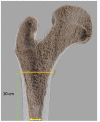Imaging in Hip Arthroplasty Management-Part 1: Templating: Past, Present and Future
- PMID: 36143112
- PMCID: PMC9503653
- DOI: 10.3390/jcm11185465
Imaging in Hip Arthroplasty Management-Part 1: Templating: Past, Present and Future
Abstract
Hip arthroplasty is a frequently used procedure with high success rates. Its main indications are primary or secondary advanced osteoarthritis, due to acute fracture, osteonecrosis of the femoral head, and hip dysplasia. The goals of HA are to reduce pain and restore normal hip biomechanics, allowing a return to the patient's normal activities. To reach those goals, the size of implants must suit, and their positioning must meet, quality criteria, which can be determined by preoperative imaging. Moreover, mechanical complications can be influenced by implant size and position, and could be avoided by precise preoperative templating. Templating used to rely on standard radiographs, but recently the use of EOS® imaging and CT has been growing, given the 3D approach provided by these methods. However, there is no consensus on the optimal imaging work-up, which may have an impact on the outcomes of the procedure. This article reviews the current principles of templating, the various imaging techniques used for it, as well as their advantages and drawbacks, and their expected results.
Keywords: 3D parameters; CT; arthroplasty; hip; radiographs.
Conflict of interest statement
The authors declare no conflict of interest.
Figures








Similar articles
-
EOS Imaging is Accurate and Reproducible for Preoperative Total Hip Arthroplasty Templating.J Arthroplasty. 2021 Mar;36(3):1143-1148. doi: 10.1016/j.arth.2020.09.051. Epub 2020 Oct 8. J Arthroplasty. 2021. PMID: 33616064
-
Primary hip arthroplasty templating on standard radiographs. A stepwise approach.Acta Orthop Belg. 2010 Aug;76(4):432-42. Acta Orthop Belg. 2010. PMID: 20973347
-
The accuracy of digital templating in uncemented total hip arthroplasty.Arch Orthop Trauma Surg. 2019 Feb;139(2):263-268. doi: 10.1007/s00402-018-3080-0. Epub 2018 Dec 6. Arch Orthop Trauma Surg. 2019. PMID: 30523444 Free PMC article.
-
Imaging in Hip Arthroplasty Management Part 2: Postoperative Diagnostic Imaging Strategy.J Clin Med. 2022 Jul 29;11(15):4416. doi: 10.3390/jcm11154416. J Clin Med. 2022. PMID: 35956033 Free PMC article. Review.
-
Benefits of CT Scanning for the Management of Hip Arthritis and Arthroplasty.Surg Technol Int. 2020 May 28;36:364-370. Surg Technol Int. 2020. PMID: 32196566 Review.
Cited by
-
A Comparison of Radiographic Outcomes after Total Hip Arthroplasty between the Direct Lateral Approach and Posterior Lateral Approach with EOS 2D/3D X-Ray Imaging System.Orthop Surg. 2023 May;15(5):1312-1324. doi: 10.1111/os.13726. Epub 2023 Apr 19. Orthop Surg. 2023. PMID: 37076774 Free PMC article.
-
A Standardised Protocol for Pre-operative Pelvic Radiographs for Templating in Total Hip Arthroplasty.Cureus. 2023 Dec 17;15(12):e50687. doi: 10.7759/cureus.50687. eCollection 2023 Dec. Cureus. 2023. PMID: 38229784 Free PMC article.
-
Optimizing Acetabular Positioning: A Comprehensive Review of Contemporary Strategies in Total Hip Arthroplasty.Cureus. 2024 Apr 26;16(4):e59114. doi: 10.7759/cureus.59114. eCollection 2024 Apr. Cureus. 2024. PMID: 38803755 Free PMC article. Review.
-
Stem design affects templating adherence in total hip arthroplasty - a retrospective cohort study comparing two types of cementless short stems.J Orthop Surg Res. 2025 Apr 17;20(1):383. doi: 10.1186/s13018-025-05801-4. J Orthop Surg Res. 2025. PMID: 40247404 Free PMC article.
-
Medullary-Sparing Antibiotic Cement Articulating Spacer Reduces the Rate of Mechanical Complications in Advanced Septic Hip Arthritis: A Retrospective Cohort Study.J Pers Med. 2024 Jan 31;14(2):162. doi: 10.3390/jpm14020162. J Pers Med. 2024. PMID: 38392594 Free PMC article.
References
-
- Cech A., Kase M., Kobayashi H., Pagenstert G., Carrillon Y., O’Loughlin P.F., Aït-Si-Selmi T., Bothorel H., Bonnin M.P. Pre-Operative Planning in THA. Part III: Do Implant Size Prediction and Offset Restoration Influence Functional Outcomes after THA? Arch. Orthop. Trauma Surg. 2020;140:563–573. doi: 10.1007/s00402-020-03342-5. - DOI - PubMed
-
- Chinzei N., Noda M., Nashiki H., Matsushita T., Inui A., Hayashi S. Conventional Computed Tomography Software Can Be Used for Accurate Pre-Operative Templating in Bipolar Hip Arthroplasty: A Preliminary Report. J. Clin. Orthop. Trauma. 2021;13:1–8. doi: 10.1016/j.jcot.2020.09.003. - DOI - PMC - PubMed
Publication types
LinkOut - more resources
Full Text Sources
Miscellaneous

